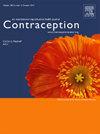提供者在肯尼亚公共设施中插入和删除LARC方法的信心和意愿。
IF 2.3
2区 医学
Q1 OBSTETRICS & GYNECOLOGY
引用次数: 0
摘要
目的:在过去十年中,肯尼亚长效可逆避孕(LARC)的使用有所增长,但新出现的证据表明,在LARC的移除方面存在挑战。本文的目的是记录提供者在LARC插入/移除方面的培训,并更好地了解提供者在插入和移除LARC方面的经验、信心和意愿。研究设计:在本文中,我们对基苏木县(肯尼亚西部)所有137家公共卫生保健机构的计划生育提供者的自我报告数据进行了描述性分析。我们评估了公共部门提供者培训的频率、经验、信心和插入和删除LARC的意愿,以及信心和提供这些服务的意愿之间的关系。结果:在我们的研究中,相当大比例的提供者缺乏植入和取出植入物和宫内节育器的培训。总的来说,提供者报告说他们更有经验,更自信,更愿意植入而不是取出植入物。接受过宫内节育器插入培训的提供者中有五分之一对其插入宫内节育器的能力没有信心,近10%的人不愿意进行插入。相比之下,接受过宫内节育器植入培训的提供者中有8%对其取出宫内节育器的能力没有信心,6%的人不愿意取出它们。提供者的信心与植入/取出植入物和宫内节育器的意愿显著相关。不到三分之二的医院有植入物(61%)或宫内节育器(58%)。结论:研究结果引起了人们对计划生育项目中生殖自主权的关注,计划生育项目极大地促进了LARC的使用。在基苏木,公共部门提供者需要更多的供应和支持,以维持信心,并确保他们愿意同等程度地参与LARC的插入和移除。本文章由计算机程序翻译,如有差异,请以英文原文为准。
Provider confidence and willingness to insert and remove long-acting reversible contraception methods in Kenyan public facilities
Objective
Use of long-acting reversible contraception (LARC) in Kenya has grown over the last decade, yet emerging evidence points to challenges in LARC removal. The objective of this paper is to document provider training in LARC insertion/removal and to better understand provider experience, confidence, and willingness to both insert and remove LARC.
Study design
In this paper we present a descriptive analysis of self-reported data from family planning providers working in all 137 public-sector healthcare facilities in Kisumu County (Western Kenya). We assess the frequency of public-sector provider training, experience, confidence, and willingness to insert and remove LARC, as well as the association between confidence and willingness to provide these services.
Results
A substantial proportion of providers in our study lacked training in the insertion and removal of both implants and intrauterine devices (IUDs). Overall, providers reported that they were more experienced, confident, and willing to insert implants rather than remove them. A fifth of providers trained in IUD insertion were not confident in their ability to insert IUDs and nearly 10% were not willing to perform insertion. In contrast, 8% of providers trained in IUD insertion were not confident in their ability to remove IUDs and 6% were not willing to remove them. Provider confidence was significantly associated with willingness to insert/remove both implant and IUD. Less than two-thirds of facilities demonstrated stock of the implant (61%) or IUD (58%).
Conclusion
Results raise important concerns about reproductive autonomy within the larger environment of family planning programs that heavily promote LARC use. Within Kisumu, public-sector providers require greater supplies and support to maintain confidence and ensure their willingness to engage in LARC insertion and removal in equal measure.
Implications
We find that many providers at public sector healthcare facilities in Kisumu, Kenya lacked training in LARC insertion and removal. Providers reported that they were more experienced, confident, and willing to insert rather than remove implants, which poses a potential threat to reproductive autonomy.
求助全文
通过发布文献求助,成功后即可免费获取论文全文。
去求助
来源期刊

Contraception
医学-妇产科学
CiteScore
4.70
自引率
17.20%
发文量
211
审稿时长
69 days
期刊介绍:
Contraception has an open access mirror journal Contraception: X, sharing the same aims and scope, editorial team, submission system and rigorous peer review.
The journal Contraception wishes to advance reproductive health through the rapid publication of the best and most interesting new scholarship regarding contraception and related fields such as abortion. The journal welcomes manuscripts from investigators working in the laboratory, clinical and social sciences, as well as public health and health professions education.
 求助内容:
求助内容: 应助结果提醒方式:
应助结果提醒方式:


